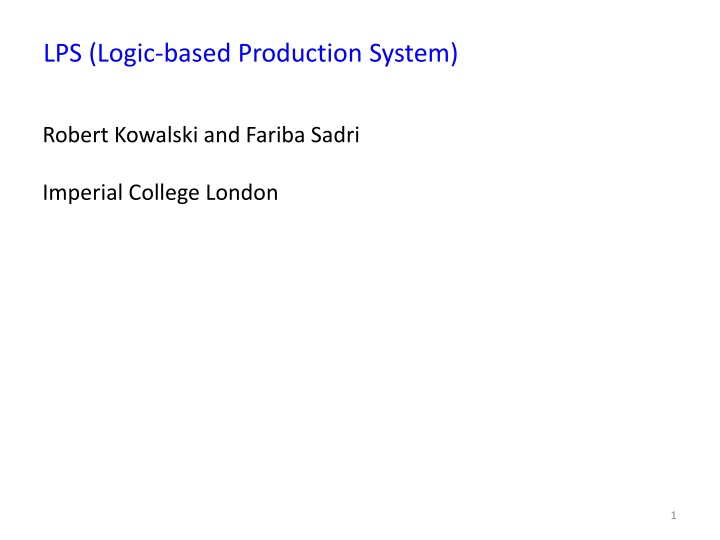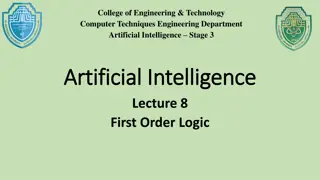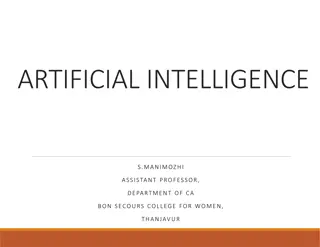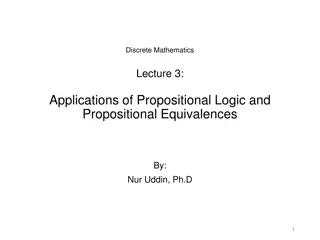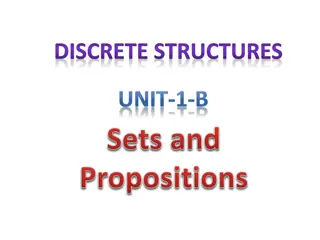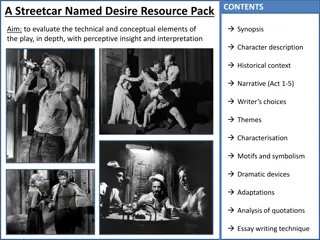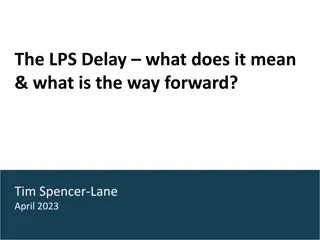Logic-Based Production System (LPS) by Robert Kowalski and Fariba Sadri
LPS, developed at Imperial College London, is a logic-based production system that combines reactive rules with logic programs to provide a logical semantics for production systems. It is used for practical programming, databases, AI knowledge representation, and problem solving. LPS is known for its implementation under development and its applications in various scenarios like the Turing test and bank account transfers. Additionally, it contrasts production systems that lack a logical semantics, showcasing the effectiveness of LPS in decision-making processes.
Download Presentation

Please find below an Image/Link to download the presentation.
The content on the website is provided AS IS for your information and personal use only. It may not be sold, licensed, or shared on other websites without obtaining consent from the author.If you encounter any issues during the download, it is possible that the publisher has removed the file from their server.
You are allowed to download the files provided on this website for personal or commercial use, subject to the condition that they are used lawfully. All files are the property of their respective owners.
The content on the website is provided AS IS for your information and personal use only. It may not be sold, licensed, or shared on other websites without obtaining consent from the author.
E N D
Presentation Transcript
LPS (Logic-based Production System) Robert Kowalski and Fariba Sadri Imperial College London 1
LPS (Logic-based Production System) Robert Kowalski and Fariba Sadri Imperial College London Incomplete, but usable implementation under development at: https://bitbucket.org/lpsmasters/lps_corner with acknowledgements to Miguel Calejo 2
LPS (Logic-based Production System) A logic and computer language for practical programming databases AI knowledge representation and problem solving 3
Outline: LPS gives a logical semantics to production systems LPS combines reactive rules with logic programs The Turing test in LPS Bank account transfer in LPS Dining philosophers in XSB/Studio implementation of LPS CLOUT (Computational Logic for Use in Teaching in Schools) 4
Production Systems Combine states described by a working memory of facts. state transitions represented by condition-action rules. Popular for implementing expert systems. as a computational model of human thinking (e.g. SOAR, ACT, Steven Pinker sHow the Mind Works) 5
Production systems do not have a logical semantics. threat deal-with-threat fire threat flood threat deal-with-threat eliminate deal-with-threat escape 6
Production systems do not have a logical semantics. threat deal-with-threat fire threat flood threat deal-with-threat eliminate deal-with-threat escape Adding fire to working memory triggers two candidate actions eliminate and escape. Conflict resolution decides between them. 7
LPS combines logic programs and FOL reactive rules threat deal-with-threat Reactive rule: Logic program: threat fire threat flood deal-with-threat eliminate deal-with-threat escape 8
LPS combines logic programs and FOL reactive rules threat deal-with-threat Reactive rule: Logic program: threat fire threat flood deal-with-threat eliminate deal-with-threat escape Adding fire to the current state generates two alternative actions eliminate or escape. LPS generates one model to make the reactive rule true. M1 = {fire, threat, deal-with-threat, eliminate} or M2 = {fire, threat, deal-with-threat, escape} 9
LPS combines logic programs and FOL reactive rules threat deal-with-threat Reactive rule: Logic program: threat fire threat flood deal-with-threat eliminate deal-with-threat escape Adding fire to the current state generates two alternative actions eliminate or escape. LPS generates one model to make the reactive rule true. M1 = {fire, threat, deal-with-threat, eliminate} or M2 = {fire, threat, deal-with-threat, escape} The current implementation in Prolog generates M1. 10
LPS combines logic programs with reactive rules in FOL. e.g. logic programs e.g. reactive rules 11
LPS combines logic programs and FOL reactive rules Reactive rules in FOL: X [antecedent Y [consequent] antecedent if antecedent then consequent or or consequent 15
LPS combines logic programs and FOL reactive rules Reactive rules in FOL: X [antecedent Y [consequent] antecedent if antecedent then consequent or or consequent Clauses in logic programming form: X [conditions conclusion] or conclusion conditions or conclusion if conditions 16
LPS combines logic programs and FOL reactive rules Reactive rules in FOL: X [antecedent Y [consequent] antecedent if antecedent then consequent or or consequent Clauses in logic programming form: X [conditions conclusion] conclusion conditions conclusion if conditions or or Atomic sentences are a special case of clauses. 17
LPS combines logic programs and FOL reactive rules Reactive rules in FOL: X [antecedent Y [consequent] antecedent if antecedent then consequent or or consequent Clauses in logic programming form: X [conditions conclusion] conclusion conditions conclusion if conditions or or Atomic sentences are a special case of clauses. The syntax of LPS is fluid. 18
The Turing Test (not completely catered for in the current implementation) sentence(Agent, T1, T3) noun-phrase(Agent, T1, T2) verb-phrase(Agent, T2, T3) noun-phrase(Agent, T1, T3) adjective(Agent, T1, T2) noun(Agent, T2, T3) adjective(Agent, T1, T2) say(Agent, your, T1, T2) noun(Agent, T1, T2) say(Agent, name, T1, T2) etc.
The Turing Test (not completely catered for in the current implementation) sentence(turing, T1, T2) sentence(robot, T3, T4) T2 < T3 < T2 + 3 sec sentence(Agent, T1, T3) noun-phrase(Agent, T1, T2) verb-phrase(Agent, T2, T3) noun-phrase(Agent, T1, T3) adjective(Agent, T1, T2) noun(Agent, T2, T3) adjective(Agent, T1, T2) say(Agent, your, T1, T2) noun(Agent, T1, T2) say(Agent, name, T1, T2) etc.
The same clauses can be used to recognise complex events and to generate complex plans Observed events: say(turing, what, 1, 2) say(turing, is, 2, 3) say(turing, your, 3, 4) say(turing, name, 4, 5) Action events: say(robot, my, 7, 8) say(robot, name, 8, 9) say(robot, is, 9, 10) say(robot, bob, 10, 11) The actions make the reactive rule true.
States and events can be described by atomic sentences without time stamps for efficient updates with time stamps for logical semantics 22
States and events can be described by atomic sentences without time stamps for efficient updates with time stamps for logical semantics States (sets of facts, also called fluents}: balance(bob, 0) balance(bob, 0, 31/08/2016) 23
States and events can be described by atomic sentences without time stamps for efficient updates with time stamps for logical semantics States (sets of facts, also called fluents): balance(bob, 0) balance(bob, 0, 31/08/2016) Events (including actions): transfer(fariba, bob, 10, 31/08/2016, 1/9/2016) transfer(fariba, bob, 10) 24
State transitions are performed by destructive updates without explicit timestamps. state at time 0: balance(bob, 0) balance(fariba, 100) 25
State transitions are performed by destructive updates without explicit timestamps. state at time 0: balance(bob, 0) balance(fariba, 100) events from time 0 to time 1: state at time 1: transfer(fariba, bob, 10) balance(bob, 10) balance(fariba, 90) 26
State transitions are performed by destructive updates without explicit timestamps. state at time 0: balance(bob, 0) balance(fariba, 100) events from time 0 to time 1: state at time 1: transfer(fariba, bob, 10) balance(bob, 10) balance(fariba, 90) events from time 1 to time 2: transfer(fariba, bob, 20) state at time 2: balance(bob, 30) balance(fariba, 70) 27
State transitions are performed by destructive updates without explicit timestamps. state at time 0: balance(bob, 0) balance(fariba, 100) events from time 0 to time 1: state at time 1: transfer(fariba, bob, 10) balance(bob, 10) balance(fariba, 90) events from time 1 to time 2: transfer(fariba, bob, 20) state at time 2: balance(bob, 30) balance(fariba, 70) events from time 2 to time 3: state at time 3: balance(bob, 30) balance(fariba, 70) etc. 28
State transitions are performed by destructive updates without explicit timestamps. state at time 0: balance(bob, 0) balance(fariba, 100) events from time 0 to time 1: state at time 1: transfer(fariba, bob, 10) balance(bob, 10) balance(fariba, 90) events from time 1 to time 2: transfer(fariba, bob, 20) state at time 2: balance(bob, 30) balance(fariba, 70) events from time 2 to time 3: state at time 3: balance(bob, 30) balance(fariba, 70) etc. Frame axioms are emergent properties, not used for computation: balance(X, N, T2) balance(X, N, T1) transfer(X, Y, V, T1, T2) transfer(Y, X, W, T1, T2) 29
State transitions are described by a causal theory with or without timestamps Postconditions: balance(X, N-V, T2) transfer(X, Y, V, T1, T2) balance(X, N, T1) balance(Y, M+V, T2) transfer(X, Y, V, T1, T2) balance(Y, M, T1) 30
State transitions are described by a causal theory with or without timestamps Postconditions: balance(X, N-V, T2) transfer(X, Y, V, T1, T2) balance(X, N, T1) balance(Y, M+V, T2) transfer(X, Y, V, T1, T2) balance(Y, M, T1) Preconditions: not [transfer(X, Y, V, T1, T2) balance(X, N, T1) V > N] not [transfer(X, Y1, V1, T1, T2) transfer(X, Y2, V2, T1, T2) Y1 Y2] etc. 31
Dining philosophers (in the XSB/Studio implementation) fluent(available(Fork)). event(time_to_eat(Philosopher)). action(think(Philosopher)). action(pickup_forks(Fork1, Philosopher, Fork2)). action(eat(Philosopher)). action(putdown_forks(Fork1, Philosopher, Fork2)). 34
Dining philosophers (in the XSB/Studio implementation) fluent(available(Fork)). event(time_to_eat(Philosopher)). action(think(Philosopher)). action(pickup_forks(Fork1, Philosopher, Fork2)). action(eat(Philosopher)). action(putdown_forks(Fork1, Philosopher, Fork2)). initial_state( [ available(fork(0)), available(fork(1)), available(fork(2)), available(fork(3)), available(fork(4)) ] ). 35
Dining philosophers (in the XSB/Studio implementation) fluent(available(Fork)). event(time_to_eat(Philosopher)). action(think(Philosopher)). action(pickup_forks(Fork1, Philosopher, Fork2)). action(eat(Philosopher)). action(putdown_forks(Fork1, Philosopher, Fork2)). initial_state( [ available(fork(0)), available(fork(1)), available(fork(2)), available(fork(3)), available(fork(4)) ] ). l_timeless(adjacent(fork(1),philosopher(1),fork(2)), []). l_timeless(adjacent(fork(3),philosopher(3),fork(4)), []). l_timeless(adjacent(fork(0),philosopher(0),fork(1)), []). l_timeless(adjacent(fork(2),philosopher(2),fork(3)), []). l_timeless(adjacent(fork(4),philosopher(4),fork(0)), []). 36
Dining philosophers (in the XSB/Studio implementation) time_to_eat(philosopher(N),T1,T2) ---> dine(philosopher(N),T3,T4), tc(T2 =< T3). 37
Dining philosophers (in the XSB/Studio implementation) time_to_eat(philosopher(N),T1,T2) ---> dine(philosopher(N),T3,T4), tc(T2 =< T3). observe([time_to_eat(philosopher(0)), time_to_eat(philosopher(1)), time_to_eat(philosopher(2)), time_to_eat(philosopher(3)), time_to_eat(philosopher(4))], 1). % currently LPS stops when no further observations exist observe([],T) :- T > 1, T < 12. 38
Dining philosophers (in the XSB/Studio implementation) time_to_eat(philosopher(N),T1,T2) ---> dine(philosopher(N),T3,T4), tc(T2 =< T3). observe([time_to_eat(philosopher(0)), time_to_eat(philosopher(1)), time_to_eat(philosopher(2)), time_to_eat(philosopher(3)), time_to_eat(philosopher(4))], 1). % currently LPS stops when no further observations exist observe([],T) :- T > 1, T < 12. dine(philosopher(N),T1,T6) :- think(philosopher(N),T1,T2), adjacent(F1,philosopher(N),F2), pickup_forks(F1,philosopher(N),F2,T3,T4), tc(T2 =< T3), eat(philosopher(N),T4,T5), putdown_forks(F1,philosopher(N),F2,T5,T6). 39
Dining philosophers (causal theory) false :- pickup_forks(F1,philosopher(N),F2,T1,T2), not available(F1,T1). false :- pickup_forks(F1,philosopher(N),F2,T1,T2), not available(F2,T1). false :- pickup_forks(F1,philosopher(N),F,T1,T2), pickup_forks(F,philosopher(K),F2,T1,T2). 40
Dining philosophers (causal theory) false :- pickup_forks(F1,philosopher(N),F2,T1,T2), not available(F1,T1). false :- pickup_forks(F1,philosopher(N),F2,T1,T2), not available(F2,T1). false :- pickup_forks(F1,philosopher(N),F,T1,T2), pickup_forks(F,philosopher(K),F2,T1,T2). initiated available(F1) :- putdown_forks(F1,philosopher(N),F2,T1,T2). initiated available(F2) :- putdown_forks(F1,philosopher(N),F2,T1,T2). terminated available(F1) :- pickup_forks(F1,philosopher(N),F2,T1,T2). terminated available(F2) :- pickup_forks(F1,philosopher(N),F2,T1,T2). 41
CLOUT (Computational Logic for Use in Teaching) A six month project (October 2016 March 2017) to develop an open-source, web-based prototype of LPS together with motivating, modifiable examples, to support computing in schools. 43
CLOUT (Computational Logic for Use in Teaching) A six month project (October 2016 March 2017) to develop an open-source, web-based prototype of LPS together with motivating, modifiable examples, to support computing in schools. Collaborators are very welcome. 44
Conclusions LPS gives a logical, model-theoretic semantics for practical programming and databases. LPS is not a full-scale AI framework, but it can be extended. 45
